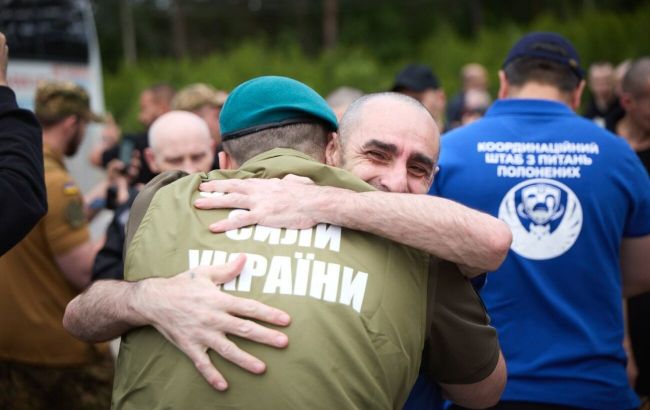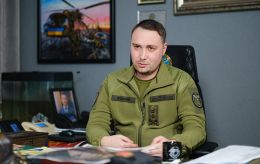Another Ukraine-Russia prisoner swap: Wounded, missing now home (photos, video)
 Photo: The new large-scale military exchange between Ukraine and Russia taking place in several stages (t.me/V_Zelenskiy_official)
Photo: The new large-scale military exchange between Ukraine and Russia taking place in several stages (t.me/V_Zelenskiy_official)
Ukraine and the Russian Federation conducted the next stage of the exchange of prisoners of war within the framework of agreements in Istanbul during the second round of negotiations. Today, June 12, the sides returned home groups of wounded and severely wounded fighters.
What is known about the new stage of the large exchange – in the article by RBC-Ukraine below.
As President Volodymyr Zelenskyy stated, today, our army soldiers, National Guardsmen, and border guards returned home. All of them need treatment, and, as the head of state noted, they will definitely be provided with the necessary assistance. This is already the second stage of the return of severely wounded and seriously ill warriors.
"We continue to work to bring everyone back from Russian captivity. Thanks to everyone who helps make these exchanges possible. So that each and every one is at home, in Ukraine," Zelenskyy wrote.
Photo: exchange of prisoners of war between Ukraine and the Russian Federation on June 12 (t.me/V_Zelenskiy_official)
Thus, as reported by the Coordination Headquarters for the Treatment of Prisoners of War, today a group of defenders from the category "severely wounded and seriously ill" was returned from Russian captivity.
Among those returned home are servicemen of the Armed Forces of Ukraine, in particular of the Air Assault Forces, Naval Forces, Air Forces, Territorial Defense Forces, SBS, as well as the State Border Guard Service and the National Guard of Ukraine.
Among those released today are defenders of Mariupol, who were in captivity for more than three years. All released defenders are men, representatives of the rank-and-file and sergeant corps.
Some of the Ukrainian warriors released today were considered missing in action.
In total, Ukrainians who fought on the Donetsk, Kherson, Kharkiv, Zaporizhzhia, and Luhansk fronts are returning home.
Photo: among those returned are those who were considered missing (t.me/Koord_shtab)
"The defenders released from captivity will undergo the necessary medical examination, receive assistance with physical and psychological rehabilitation, as well as all due payments for the entire time spent in captivity," the Coordination Headquarters noted.
They added that today’s exchange is part of the large exchange in the categories of servicemen aged up to 25 years, as well as severely wounded and seriously ill.
"The Coordination Headquarters continues to work, and the next stage of releasing Ukrainian defenders will be conducted shortly," summarized the Coordination Headquarters.
According to the Ombudsman Dmytro Lubinets, the oldest person released from captivity is 59 years old, the youngest – 22.
"The returned had been in captivity since the first days of the full-scale invasion. Among those returned are those who were considered missing in action," he added.
Large exchange of prisoners: what the sides agreed upon
After the second round of negotiations in Istanbul on June 2, the Ukrainian and Russian delegations agreed on the exchange of all severely wounded and seriously ill prisoners of war, as well as prisoners aged from 18 to 25 years.
It was noted that the exchange of these categories would be not by number, but according to the principle of "all for all". At the same time, in particular, the head of the Russian delegation Vladimir Medinsky made statements that the sides would transfer prisoners within the framework of the new exchange in the format of "1200 for 1200".
In addition, the sides agreed on the repatriation of about 6,000 bodies of fallen soldiers. However, President Volodymyr Zelenskyy stated that one must be cautious with the exchange of bodies because the Russians have identified no more than 15–20% of the bodies they possess.
"It is very important that we receive the bodies of Ukrainians, and not Russians, whom they want to get rid of," the president noted.
Later, on June 6, the Russians accused Ukraine of "delaying" the process of exchanging prisoners of war and bodies of the deceased. In response, the Coordination Headquarters stated that the Russian Federation submitted lists of prisoners for exchange that do not correspond to the previously agreed exchange of severely wounded and soldiers aged up to 25 years. In addition, the Russians did not follow the established procedure for the body exchange process.
Moreover, the Coordination Headquarters reported on a new Russian IPSO with phone calls to the families of prisoners.
Who has already been returned
As a result, the new large exchange still began, but not on June 7 as expected, but on the 9th. On that day, the first group of released servicemen aged up to 25 years returned home.
The number of returned soldiers was not reported. The Coordination Headquarters explained that for the sake of operational security, the final figures of those released will be announced after the exchange process is completed.
Already on June 10, the second stage of the exchange took place. Prisoners from the category "severely wounded and seriously ill" returned home. A group of defenders who suffered serious injuries and have major health problems were released from Russian captivity.
The next day, June 11, a body exchange took place as part of the agreements in Istanbul during the second round of negotiations. As a result of the repatriation measures carried out, the bodies of 1,212 fallen defenders were returned to Ukraine.
The first large-scale exchange of prisoners of war between Ukraine and Russia took place after direct negotiations in Türkiye held on May 16. At that time, the sides agreed to conduct an exchange according to the formula "1000 for 1000" over the course of three days – from May 23 to 25.
As a result, Ukraine returned one thousand people, among them – servicemen of the Naval Forces, Air Assault Forces, National Guard, Territorial Defense, and border guards, as well as 120 civilians.
A significant portion of the released Ukrainians had been in captivity for more than three years – in particular, this concerns defenders of Mariupol. It was also the first time military personnel were returned from 46 units from which there had previously been no exchanges.

